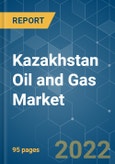The market for oil and gas in Kazakhstan is expected to register a CAGR of more than 2% during the forecast period of 2022 – 2027. The COVID-19 pandemic has negatively affected the Kazakhstan oil and gas market. In January 2022, due to concerns about the omicron variant of the coronavirus, oil prices in the country increased by 5% after the government protested Kazakhstan train lines and hit production at the country's Tengiz oilfield. Factors such as increasing refining capacity, and plans to improve oil production are expected to drive the growth for the Kazakhstan oil and gas market during the forecast period. However, Kazakhstan's largest oil and gas field has a high composition of hydrogen sulfide, thereby increasing the cost of refining and this factor is likely to restrain the market growth during the forecast period.
Key Highlights
- The upstream sector is expected to increase substantially during the forecast period, owing to the continued focus on improving oil and gas production. Kazakhstan also has one of the largest oil fields in the world, which can boost growth in the upstream sector.
- There have been significant oil discoveries in southern Kazakhstan. Economically feasible extraction of the oil may become an opportunity for the companies and may lead to a boom in oil production.
- Increasing investments in the oil and gas industry is exected to drive the Kazakhstan oil and gas market during the forecast period, owing to the increasing gas processing and refining capacities in the country.
Key Market Trends
Upstream Sector to Witness Significant Growth
- Kazakhstan is the largest economy in Central Asia and home to more than 18 million people. The country is rich in coal, oil, natural gas, and uranium. In recent days, the country has seen significant growth in its exploration and production activities.
- As of 2020, oil production increased by 6.84%, to 1811 thousand of barrels per day in 2020 from 1695 thousand of barrels per day in 2015. Increased Investment in oil projects by the government is the most prominent reason for the increase in oil production in the country.
- Kazakhstan's primary export oil grade is the Caspian Pipeline Consortium (CPC) Blend. CPC Blend is of light quality with an API (American Petroleum Institute) gravity of 45.3° and sweet crude (0.56% sulfur), which is of high value for its high yield of gasoline and light distillates. Most of the CPC blend is produced from the Tengiz field.
- In November 2021, the Chevron-led consortium that operates the Tengiz Oil field has begun an early production from a USD 45 billion expansion project which is intended to lift output to 850,000 b/d. Tengizchevroil consortium had brought on-stream three metering stations producing 100,000 b/d connected to new wells drilled as part of this expansion.
- Hence, upstream sector is expected to grow substantially owing to its increase in oil production in the forecast period.
Increasing Investments in the Oil and Gas Industry to Drive the Market
- Kazakhstan was the world's ninth-largest exporter of crude oil and 12th of natural gas as of 2020. As of 2020, natural gas exported by Kazakhstan through pipeline was 13,221.990 million cubic meters. The increase is primarily due to demand from Russian Federation and China.
- Natural gas production increased by 14.03% i.e., from 27.8 billion cubic meters in 2010 to 31.7 billion cubic meters in 2020. Consumption of natural gas increased by 22.06% i.e., from 9.5 bcm in 2010 to 16.6 bcm in 2020. Therefore, increasing demand for natural gas is boosting the investments within the country.
- In 2021, the Ministry of Energy, Kazakhstan announced USD 116.8 million for the implementation of 146 oil & gas projects across the country. The allocated budget is utilised for the extension of gas networks that provides access to gas for around 10,388 thousand people within the country.
- Moreover, in June 2021, Kazakhstan has started construction of a new gas processing plant in the Makat district in the Atyrau region, near the existing onshore Bolashak oil and gas treatment complex. The project has an investment cost of USD 860 million and has a capacity to process 1 billion cubic meter/year of sulfur dioxide from the Kashagan field.
- Hence, increasing investments in oil & gas industry is expected to drive the market due to the addition of fresh capacity. An increase in the demand from neighboring countries like the Russian Federation and China is also expected to provide boost to the market during the forecast period.
Competitive Landscape
The Kazakhstan oil and gas market is moderately consolidated. The major companies include National Company JSC (KazMunayGas), Chevron Corporation, Karachaganak Petroleum Operating B.V., PJSC Gazprom, and PJSC Lukoil Oil Company.
Additional Benefits:
- The market estimate (ME) sheet in Excel format
- 3 months of analyst support
Table of Contents
Companies Mentioned (Partial List)
A selection of companies mentioned in this report includes, but is not limited to:
- National Company JSC (KazMunayGas)
- Chevron Corporation
- Karachaganak Petroleum Operating B.V.
- PJSC Gazprom
- PJSC Lukoil Oil Company
Methodology

LOADING...










